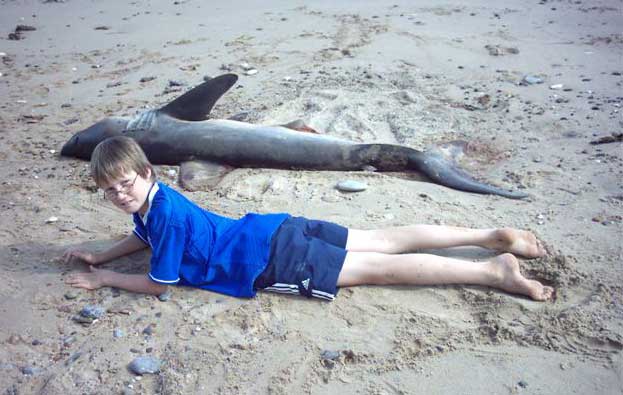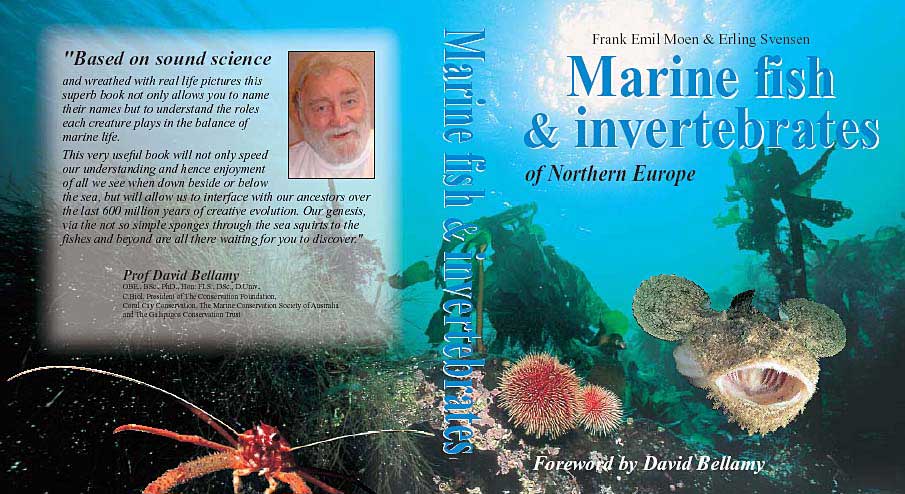
|
|
|
|
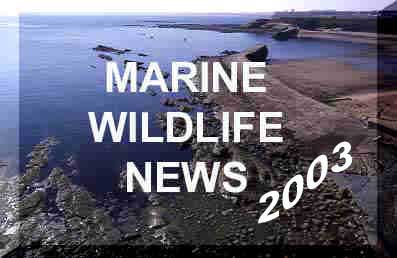 |
|
Norwegian Marine*** |
|
L-I-N-K-S to Other Sites (Click on Text) |
|
Smart Group |
|
|
|
|
|
|

Monthly Marine News Bulletin |
|
Marine Nature Conservation Review Survey Database |
|
|
 |
|
|
|
|
|
|

Reports
of marine wildlife from all around the British Isles, with pollution incidents
and conservation initiatives as they affect the fauna and flora of the
NE Atlantic Ocean.
For
more reports click on the seasonal buttons below:
on Microsoft Internet Explorer (best) or Netscape
 |
 |
 |
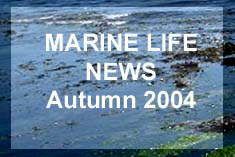 |
LATEST NEWS
8 December 2004
NB: This species of dolphin is not often recorded in the eastern English Channel.
A pod of seven White-beaked Dolphins, Lagenorhyncus albirostris, off Dungeness, Kent. They gave a spectacular display including leaping clear of the water as they fed and were in view for most of the afternoon. I have looked at the sea on an almost daily basis at Dungeness since 1989 and this is the first time I have seen White-beaked Dolphins.
BMLSS Cetacea7 December 2004
Commercial fisherman Andy Le Prevost trawling on the Lady Patricia caught a Almaco Jack, Seriola rivoliana, (originally identified as a Guinean Amberjack, Seriola carpenteri), on the south-west Casquet bank, near the Channel Islands, at night.The fish was caught at a water depth of 25 metres. The fish was small (length: 30.7 cm, weight: 637 grams) and similar in size to the specimen caught by George Staples east of Herm Island on 7 September 2000. The sea temperature was 11.7°C. My records indicate that this is the fourth confirmed Amberjack species caught in Channel Island waters.
Full Details
ID Details
Previous RecordReport and Photograph by Richard Lord (Guernsey)
on the Marine Wildlife of the North-east Atlantic Ocean Group
6 December 2004
A 40 cm long Flying Gurnard, Dactyloptena orientalis, was hauled up in a herring net less than a mile from Penzance. The fish is being kept at the Blue Reef Aquarium in Newquay after skipper Tony Richards, from St. Ives, kept it alive.Flying Gurnard
Photograph by Jim Greenfield (taken in Gozo)“We were in only about 15 metres depth and were hauling up our herring nets by hand. It was the last fish in the net. I could feel by touching that it was an extraordinary specimen — its skin is armoured. It had a flat head and when I picked it up it spread its wings. They are as wide as the fish is long, about 40 cm.
“It is a beautiful animal. Its wings are all different colours: blue, red, yellow and grey. I’ve never seen anything like it in all my years at sea. It’s an incredible beast.”Report from Times On-LineCornish Marine Wildlife (Ray Dennis Records) 20041 December 2004
Guernsey commercial fisherman Steve Fallaize landed a handsome Couch's
Sea Bream, Pagrus pagrus, on weighing 2688 grams whole (5.93 lb). The fish was netted in a water depth of about 20 to 25 metres over a mixed shell-gravel bottom off Guernsey's west coast.This is the largest Couch's Sea Bream that I have recorded in Guernsey.Small Couch's Sea Bream have been frequently landed in recent years around the Channel Islands, but this is a southern fish and it is uncommon any further north.
Report and Photograph by Richard Lord (Guernsey)
on the Marine Wildlife of the North-east Atlantic Ocean Group
7 November 2004
A 440 mm Bonito, Sarda sarda, and a similarly sized Twaite Shad, Alosa fallax, were caught in a gill net set by fisherman Mark Green near to La Tour de Rozel, on the north-east coast of Jersey. It was the second Bonito I have seen from Channel Islands seas, and it's been quite a good year for the anadromous Twaite Shad.
BMLSS Tunnies
31 October 2004
Fin Whale washed in by the gales and stranded dead
on Aires Point, near Sennen Cove, Cornwall
Photographs by Jane HerbertA second Fin Whale, Balaenoptera physalis, was discovered washed dead on the rocky shore at Aires Point near Sennen Cove (near Land's End) on the Cornish coast.
Report by Vince Smith on the Cornish Mailing ListBBC News Report
Cornish Marine Wildlife News
Fin Whale Stranding Picture Portfolio
BMLSS CetaceaBMLSS Seahorse Page
30 October 2004
A Whiting was caught on rod and line four miles out of Brighton, Sussex, and it promptly regurgitated a Seahorse, Hippocampus sp. Seahorses are not known off the Sussex coasts, although I have received at least one unconfirmed sighting before. This is probably the Short-snouted Seahorse, Hippocampus hippocampus.
Seahorse Trust
Seahorse SurveyBoth species of seahorses recorded from British seas have been recommended by English Nature for full protection under under the Wildlife and Countryside Act (1981). This will be subject to public consultation.
29 October 2004
A 15 metres long Fin Whale, Balaenoptera physalis, was discovered washed up dead on the shore of St Mary Bay, near Brixham (near Torquay), in south Devon. The shape of the huge sea mammal was still intact enabling it to be recognised easily.Report by Vince Smith on the Cornish Mailing ListBBC News Report
National Whale Stranding Recording Scheme9 October 2004
A visit to three shores in northern Cornwall brought the first report of a Violet Snail, Janthina janthina, with the recent spate of By-the-wind Sailors, Velella velella, strandings. Two shells, one alive and one dead, discovered by Julie Hatcher (Kimmeridge Bay Marine Nature Reserve) on Widemouth Bay beach, near Bude. The strandline was covered in the white skeleton shells of Velella several centimetres thick.
Not only the shell but the soft body of the Violet Snail is also a violet colour. This gastropod feeds of on Velella and secretes a mucus bubble-raft to keep in buoyant. Another animal (a crustacean) that secretes a polystyrene-like raft to keep it afloat is the Buoy Barnacle, Dosima fascicularis, which were present in their hundreds and were still be swept in on to the beach to strand and die. These were more numerous than at least two species of Goose Barnacles, the commonest was Lepas anatifera and the other smaller one washed up was the Duck Barnacle, Lepas pectinata. These two barnacles are always attached to floating debris and are not pelagic, but sessile animals when adult and they become stranded on the shore when the object they attach themselves to becomes dislodged and floats away.Report by Steve TrewhellaBMLSS Barnacles5 October 2004
A 347mm TL (315mm FL) Guinean Amberjack, Seriola carpenteri, was caught by Lee Allen and Gary Cann from a boat close to La Corbiere Lighthouse (SW Coast of Jersey) in a gill net, set in depth of 15 metres over sand and a shallow reef. Fin & Feather of St Helier Fishmarket brought this unusual capture to my notice. This sub- tropical fish has only been recorded twice before in the Channel Islands and has not been recorded on the northern side of the English Channel. The very first capture was in September 2000, with the identification confirmed by Alwyn Wheeler at the Natural History Museum (London). This new record is not yet confirmed.NB: Care must be taken to avoid confusion with the Amberjack, Seriola dumerili, which the original fish was originally identified as, and this is also a rare vagrant fish form southern seas.
October 2004
The Warty or Yellow Crab, Eriphia verrucosa (= E. spinifrons), was discovered off the Cornish coast and it has found a home in the National Aquarium at Plymouth. This appears to be the first record in British waters of this little known (in England) crab that inhabits southern seas from Brittany (France) to Mauritania (north Africa), and with a widespread distribution in the Mediterranean, so it is surprising that vagrant crabs have not appeared before.Report from Doug Herdson (National Marine Aquarium, Plymouth)
29 September 2004
One of the most extraordinary shark tales involved the discovery of a tropical Oceanic White-tip Shark, Carcharhinus longimanus, that had badly lost its way and was discovered swimming around a warship in a brackish water fjord near Gullmarsfjorden in west Sweden. It died shortly afterwards. The shark, a male, was 230 cm long, (total length), and weighed 65.65 kg. This is the first record in northern European seas and it has never been discovered around the British coast. A Swedish Museum in Gothenburg has now the shark for further examination.Report and Identification by Kent AnderssonThe Oceanic White-tip Shark is found worldwide in epipelagic tropical and subtropical waters between 20° North and 20° South latitude. Its range is from Portugal to the Gulf of Guinea in the eastern Atlantic. There are a few records from the Mediterranean Sea. It lives in sea temperatures above 21° C. It is usually found over deep water a long way from the shore. It is known to associate with Pilot Whales and may follow boats or ships if a constant food source is available. This shark has a reputation for attacking Man.
How could the shark have arrived in the fjord? The speculation could involves man's activities as a discard from a deep water fishing catch?
Further Information
Fishbase entry
BMLSS SharksLate September 2004
A jack fish known as the Blue Runner, Caranx crysos, was caught by a fisherman in a bass net just off Mevagissey, Cornwall, and taken in to Chris Gilbertson at Mevagissey Aquarium, who passed it on to me for identification. This is thought to be the fourth or fifth specimen of this fish reported in the UK.The jack family of fish (Carangidae) are widespread in the warmer waters of the world, but the only member of the family which is common in the North East Atlantic is the Horse Mackerel or Scad Trachurus trachurus. Carangids seem to be being found more regularly as the temperature of local waters increases.
Report from Doug Herdson (National Marine Aquarium, Plymouth)
on the Marine Wildlife of the North-east Atlantic Ocean Group
UK Public Aquaria List
Cornish Marine Wildlife (Ray Dennis Records) 200427 September 2004
Pair trawling for sea bass banned in UK Territorial waters
Fisheries Minister Ben Bradshaw has announced a unilateral ban on pair trawling for sea bass effective immediately at the Labour Party conference in Brighton.
The ban will be implemented within the 20 km (12 mile) limit of the UK's waters. This will not prevent the dolphin deaths but will prevent any more damage to inshore breeding grounds.
BBC News Report25 September 2004
A 20 metres long, 30 tonne, Fin Whale, Balaenoptera physalis, was washed up dead on the mud flats at St Brides, West Usk, in south Wales, near Newport on the shores of the Bristol Channel.
18-25 September 2004
The massive stranding of By-the-wind Sailors, Velella velella, has now been established that it has stretched much further than just the Cornish coast and that the numbers were in billions.Velella on Constantine Bay beach, north Cornwall
Photograph by Amanda BertuchiReports of large numbers of large specimens and huge numbers occurred all along the Welsh coast as far north as Anglesey and almost certainly further north as well.
Full Report21-23 September 2004
First strandings on Velella on the sandy beach at Polzeath, Cornwall
Photograph by Jonathan SmithA huge mass stranding of By-the-wind Sailors, Velella velella, occurred all along the north Cornish coast from Sennen Cove (near land's End) up to Polzeath (near Padstow) and beyond. (As the gull flies this is a distance of 25 miles and with all the coves and inlets the shoreline is over double this.) Coming in on the top of the tide, there were hundreds of millions of them, all large, the largest I found was 85 mm, and all them were intact. Millions of Barnacles were washed up along the strandline.
Report by Nick Darke via the Cornish Mailing List
BMLSS Velella Reports
BMLSS Strandlining
BMLSS Jellyfish and other Medusae
BMLSS BarnaclesMid-September 2004
An Amberjack, Seriola sp., caught by an angler off the rocks of the Lizard peninsula, Cornwall, in mid-September and taken to Matt Slater at the Blue Reef Aquarium in Newquay for identification, will be a new British rod-caught record. It is thought to be a Lesser Amberjack, Seriola fasciata, which has never been recorded in Britain before, but could turn out to be an Almaco Jack, Seriola rivoliana, which would be the sixth for British waters, and the first taken by an angler.Report from Doug Herdson (National Marine Aquarium, Plymouth)
on the Marine Wildlife of the North-east Atlantic Ocean Group1 September 2004
The European Commission in Brussels rejected Britain's call for a ban on pair trawling for bass throughout the English Channel to save dolphins.
Ben Bradshaw, the fisheries minister, had asked the European Commission for an emergency ban after hundreds more dolphins were washed up dead on the beaches of the South-West this year.
BBC News Report28-29 August 2004
Third National Whale and Dolphin Watch (sponsored by BG Group, DEFRA &
the Heritage Lottery Fund) took place around the UK with watches conducted from about 200 sites from Shetland to Cornwall & the Channel Islands.
Sea Watch FoundationAugust 2004
Brian Richardson diving in 18 metres of water off the South Devon Coast thought he saw the unusual echiuran species collectively known as Spoon Worms but more often by the scientific name of Bonellia viridis. Only the proboscis was seen, which was about 60 cm long with a T piece 10 cm wide. When touched, the expandable proboscis recoiled under a rock.Report from Doug Herdson (National Marine Aquarium, Plymouth)
on the Marine Wildlife of the North-east Atlantic Ocean Group
I expect most people have not had a chance to see such a bizarre and unusual creature.Full Report with more information and links to photographs
July 2004
BMLSS Halibut
A huge Atlantic Halibut, Hippoglossus hippoglossus, weighing 190 kg was caught from Vannaya Troms, Norway by Thomas Nielsen from Vannaya Troms, Norway.
July 2004
We discovered a 1.93 metres (6 ft 4 in) long fresh shark washed up dead on the beach between Hornsea and Mappleton on the Yorkshire North East coast.Report by Rae Atkins
Photographs by Rae Atkins
This shark appears to be a Porbeagle Shark, Lamna nasus. There is a population of this large predatory shark in the North Sea. Their occurence may match the Salmon on which they prey. Specimens washed up dead on the beach are unusual.
BMLSS Sharks12-14 July 2004
We sailed through huge masses of By-the-wind Sailors, Velella velella, on route from Larne (Northern Ireland) to La Coruna in Spain; it took us approximately two days to clear them. Buoy Barnacles, Dosina fascicularis, attached to floats that they had secreted, were also present in very large numbers.Report by Claire Mullen
c. 4 July 2004
While diving at the Shiant Isles in the in the Minch between Skye and Lewis in the Outer Hebrides (islands off north-west Scotland) I found the large starfish Stichastrella rosea, an echinoderm I have never seen outside of St Kilda. Better still, I also found what looks like this starfish but it had seven arms instead of the usual five. This starfish seems to be uncommon and found off the northern and western coasts, usually in deeper water than 30 metres so it is rarely seen by divers.
Image
18 June 2004
A new film called Deep Blue from the makers of the Blue Planet opens in good
cinemas.
Trailer (Link)
June 2004
A pregnant male Seahorse, Hippocampus guttulatus, was discovered and photographed in Poole Bay, Dorset. This is the first recorded instance of a pregnant Seahorse in the northern English Channel and anywhere in the seas surrounding the British Isles and is therefore the first confirmed instance of successful breeding, which has long been suspected. Discharge of the young into the shallow sheltered ways of Poole Bay seemed imminent.Report and Photograph by Steve Trewhella (Poole, Dorset)BMLSS Seahorses17 June 2004
Five Basking Sharks, Cetorhinus maximus, were found washed up dead on the Cornish coast in the space of a week, with the latest discovered at Perranporth, North Cornwall. Others have been washed up dead, at Gerran Bay, Coverack, Roseland Bay and the Fal estuary.
News Report
BMLSS Basking Sharks13 June 2004
A young female Hooded Seal, Cystophora cristata, was discovered on Dunnet Beach, Caithness, Scotland. It was treated by British Divers Marine Life Rescue who plan to return the seal to the Orkney Isles nearer its natural habitat around Greenland and the Denmark Strait (between Iceland and Greenland).Report by Alistair Jack of British Divers Marine Life RescueBritish Marine Life Rescue News Page (with the Full Report)
BMLSS Seals6 June 2004
An extraordinary raft of Moon Jellyfish, Aurelia aurita, was seen eight miles (13 km) off the coast of north-west Wales, off the Lleyn peninsula at the north of Cardigan Bay. The Moon Jellyfish had somehow contrived to wedge themselves together into a continuous raft of eight metres square, each of the tens of thousands of jellyfish about 10 cm in diameter, each wedged several deep in one large teeming mass, each jellyfish "pulsing down" in the glassy dead calm sea between two headlands. This unusual congregation has been reported once before in the enclosed Scottish Loch Nevis, but has not been recorded before in the open sea.Report by Barry PughBMLSS Jellyfish5 June 2004
ADUR WORLD OCEANS DAY
Venue: Coronation Green, Shoreham-by-Sea
Adur was one of the leaders in the United Kingdom when it presented an Exhibition celebrating the official World Oceans Day. It was held in the large marquee on Coronation Green overlooking the River Adur.
I estimated the attendance on a sunny day (21.4° C) at 2,500.
Full Report
4 June 2004
A Box Crab, Paramola cuvieri, was caught 12 miles off Falmouth by fisherman Arfee Treneer, from Mylor, Cornwall. The extremely long legs of this deep water crab give it by far the largest span of any of the crabs found in the North-east Atlantic Ocean, although its body is not much larger than the Spiny Spider Crab, Maja squinado. It is a rare capture and according to the BBC Report only the sixth ever caught in British seas and second by this fisherman. This crab like all the giant long-legged crabs is an inhabitant of very deep water in excess of 150 metres and down to depths of 1500 metres. This one was caught in much shallower depths and brought alive, but damaged, to the Blue Reef Aquarium at Newquay.
BBC Report
1997 Report2 June 2004
A Sturgeon, Acipenser sp., was caught in an otter trawl in Bristol Channel south of Swansea at 2:30 pm in the small (under 10 metre) fishing vessel MFV Wonkey SA357, skippered by Robert (or Kevin) Davies. It weighed 120 kg (265 lb), and was 261 cm (8 ft 6") long (including the tail fin) and 246 cm long (excluding the tail). It was caught at a depth of between 10 and 20 metres.I believe it to be Acipenser sturio, but the snout is fairly short and blunt, more like Acipenser gueldenstaedtii (but this is a Danube/Black sea species).
Report from Doug Herdson (National Marine Aquarium, Plymouth)BMLSS SturgeonMay 2004
Marine fish & invertebrates
of Northern Europe
Frank Emil Moen & Erling SvensenIn May 2004 the English edition of the very popular Norwegian Marine Fauna (Dyreliv I havet) was published. Prof. David Bellamy has written the foreword.
Click on the image for more information.
24 May 2004
An Atlantic Sailfish, Istiophorus albicans, was spotted in Falmouth Bay, Cornwall, following a sailing boat three mile south of Black Rock.Observed by Sue Burrows via Ruth WilliamsReport on Cornish Marine Sightings (Fish)18 May 2004
BMLSS Sharks
Three professional anglers witnessed a Thresher Shark, Alopias, leap completely out of the water, tail and all, four consecutive times to the west of Alderney, Channel Islands, Great Britain at about 8:00 pm. One angler told me that he estimated the body length of the shark at about 170 cm. The leaping activity occurred about 100 metres away from their boat. The leaps were head first and perpendicular out of the water.13 May 2004
Three molluscs known as Akera bullata were seen swimming on the surface of the sea and scooped into a net from the south-east corner of Queen Elizabeth II Marina, St Helier, Jersey, in the Channel Islands (English Channel). The captured specimens were only three out of about ten and were only about 25 mm long and were returned to the marina after identification. This appears to be the first record for Jersey in a marina that provides a home for other southern species with unusual records in the recent past.
Link to the Original Message (with more information)
Report and CommentSpecimens discovered by James Letto of the States of Jersey Harbours DepartmentReport and References by Andrew Syvret on the
Marine Wildlife of the North-east Atlantic Ocean GroupBMLSS Cetacea
14 April 2004
At 10.30 am we noticed about a dozen Bottle-nosed Dolphins, Tursiops truncatus, just outside Aberdeen harbour, vigorously 'playing' with a single Harbour Porpoise, Phocoena phocoena. During 20 minutes of observation the poor porpoise was constantly attacked by at least eight adult (or fully-grown) dolphins.
Full Report (Link)
7-8 April 2004
Beautiful but if a not deadly jellyfish, the Mauve Stinger, Pelagia noctiluca, can impart a nasty sting to the unlucky swimmer. They are now being seen around the Channel Islands. I found one stranded in a rock pool by Lithou Island on the east coast of Guernsey on 7 April, 2004 and another stranded in a rock pool on the east coast south of St. Peter Port on 8 April 2004. Strandings of this jellyfish seem to occur often in spring around these islands. They are not common around the rest of the British Isles but there are reports in some years off the south and west coasts, especially off Cornwall.Report and Photograph © by Richard Lord (Guernsey)BMLSS Jellyfish: Mauve Stinger
on the Marine Wildlife of the North-east Atlantic Ocean Group
27 March 2004
A former Royal Navy frigate has been sunk off Cornwall to create the UK's first artificial diving reef. Thousands of people watched from Whitsand Bay near Plymouth as HMS Scylla was scuttled at 3:28 pm GMT.
The explosives were detonated by 12-year-old Daniel Green, from Ivybridge, Devon, accompanied by environmentalist David Bellamy.
BBC News Report26 March 2004
A Hooded Seal, Cystophora cristata, was discovered on St. Ives beach, Cornwall, by British Divers Marine Life Rescue. The Hooded Seal is an Arctic species and even discoveries off the coast of Scotland, including the Orkney and Shetland Isles are rare. It moults around Greenland and the Denmark Strait (between Iceland and Greenland).
British Divers Marine Life Rescue News Page (with the Full Report)
Hooded Seal 2001 (SW Wales)
BMLSS Seals21-22 March 2004
A 12 metre long Sperm Whale, Physeter catodon, was washed up still alive on a sand bank at Sutton Bridge in The Wash, on the east coast of England, and first spotted by a local resident at 10:00 am on 21 March 2004. Unfortunately the distressed whale was stuck on the sandbank and the rescuers are powerless to assist the 15 tonne animal back into deeper water. Efforts were made to help it stay alive and to hope it will have the strength and luck with the tides to free itself. The prognosis is poor for any chance of survival.
Unfortunately, the whale died on the second day.
BBC News Report
British Divers Marine Life Rescue News Page
BMLSS Cetacea27 February 2004
An adult male Sperm Whale, Physeter catodon, measuring nearly 15 metres in length was found stranded on the Oostduinkerke beach in Belgium. Judging by its advanced state of decomposition the large whale, the twenty-first to have been discovered on Belgium beaches since 1403, had been dead for several months before it washed up on the beach.
French News ReportReport by Yvon Godefroid on UK Cetnet
24 February 2004
A Leatherback Turtle, Dermochelys coriacea, was spotted five miles south of Mevagissey off the south coast of Cornwall. This is an unusually early sighting. They normally start appearing in UK waters in early summer.
Newquay resident Jo Leach reported the turtle after spotting it while out on her uncle's crab potting boat.
“My uncle was using his binoculars to look out for the Fin Whales that had been reported over the weekend, when he saw something that he thought looked like a rock breaking the surface”, said Jo Leach, “We approached the object and cut the engines, and when we were about five metres away we could see it was a Leatherback Turtle. It gazed at us for a few minutes and then slowly swam off, as if it had had enough of looking at us!”Report by the Marine Conservation SocietyUK Turtle Code
BMLSS Turtles
2 February 2004
A Fin Whale, Balaenoptera physalis, was found washed ashore on the island of Coll, the second found beached on a Hebridean island in recent weeks. The 17 metres long carcass was found by an islander. This whale was in a fresh condition.
News Report
The earlier whale washed up on Mull was a beaked whale of a species not known at the time of writing.Corrected report by Dr. Peter G.H. Evans on UK CetnetSea Watch Foundation
BMLSS Cetacea30 January 2004
A pod of Risso’s Dolphins, Grampus griseus, and then the even larger fin cleaved through the water, the black and white flanks revealing two Killer Whales, Orcinus orca, were spotted by a large groups birdwatchers off Fishguard, south-west Wales. These large cetaceans were a mile out to sea and seen through the birdwatchers scopes.
BBC News Report
Cetacean Sightings off Wales28 January 2004
A 12 metres long Sperm Whale, Physeter catodon, was washed up dead at Thornham Norfolk.Photograph by Richard Saunders
For spotters willing to brave the gale force winds, the whale could be seen by transversing the muddy trail from Holme NWT and following the sea bank to the beach.
Lynn News Report
The Porcupine Marine Natural History Society web pages are launched. Please click on the logo to access their pages.
The Marine Conservation Society UK Turtle Code is now online at http://www.euroturtle.org/turtlecode/
28 December 2003
A rorqual whale of over 30 tonnes is washed up dead on the sandy shore of the bay of Audierne, between Tronoën and the Torch, near Plomeur near Quimper, southern Brittany, France. Samples have been taken by Oceanopolis, Brest (Public Aquarium) who identified the species as a Fin Whale, Balaenoptera physalis, that had recently died and measured 19.5 metres in length.
Full Report
19 December 2003
A "superpod" of thousands of dolphins was spread over about two and a half miles off Nare Head, on the Roseland Peninsula, Cornwall. The species involved is the Common Dolphin, Delphinus delphis, of all age groups including calves and mothers. Other small cetacean species were possibly present. These superpods are a rare once in a lifetime event around the British coast, but very large pods have been seen off the Cornish coast in recent years, the previous one occurring at the beginning of the year. The superpod was accompanied by hundreds of sea birds including Guillemots and Gannets feeding on Mackerel.First News Report by Franck Dupraz et Océane Grège via UK Cetnet"Western Morning News" Report
Large Pods of Dolphins off Cornwall in January 2003 (1)
Large Pods of Dolphins off Cornwall in January 2003 (2)
BMLSS Cetacea18 December 2003
Two Humpback Whales, Megaptera novaengliae, were seen near The Hague (Den Haag), Zuid-Holland. They were discovered by the local department of the lifeboat association who prevented the whales from swimming towards the coast. At dusk they lost the animals near ´s-Gravenzande, some 10 kilometres south of The Hague. The animals were estimated to be 8 and 18 metres long. They were not seen by any of the local sea-migration watchers; the Humpbacks were identified by the pictures made by one of the members of the lifeboat. The identification was confirmed by Kees Camphuysen.
This is the first record of living Humpbacks for the Netherlands.
Full Report on UK CetnetReport by Vincent van der Spek via UK CetnetTwo large whales swam along the Dutch coast near Scheveningen. They were identified as Humpback Whales, Megaptera novaengliae, from the photographs.
Report (in Dutch) with links to PhotographsReport by Jan Wouter via UK CetnetPrevious Record (September 2003)
Tragically, on 20 December 2003, a pair of Humpback Whales, Megaptera novaengliae, a male and a young whale, were caught in a fishing net and died.Report by Jamie Duffie via UK CetnetCarcass Photographs
BMLSS Cetacea5 December 2003
A medium-sized Bluefin Tuna, Thunnus thynnus, was landed at Plymouth Fish Market. It was caught about 24 nautical miles east of Lizard Point, SW Cornwall in a mid-water pair trawl. Adult Bluefin Tuna are no longer caught regularly caught off England and the last one on record was caught in 1968.Report from Doug Herdson (National Marine Aquarium, Plymouth)Full Report
on the Marine Wildlife of the North-east Atlantic Ocean Group
BMLSS Tunnies4 December 2003
Walkers along the coast at Bovisand in Devon were treated to a rare sight as a five metre long whale was temporarily stranded close to the shore in Heybrook Bay. It has been identified as a Northern Bottle-nosed Whale, Hyperoodon ampullatus, after originally being identified as a Pilot Whale. The malnourished whale was spotted by a walker, Steve Blackhouse, who quickly rang the Coastguard. Bottlenose Whales are rarely seen in the English Channel, normally preferring in waters up to 1,000 metres deep, off the continental shelf.
"Western Morning News" Report
Marine Mammals of the UK Smart Group
British Marine Life Rescue Report
BMLSS Cetacea
Links for News Reports:
Helford (Cornwall) Marine Conservation Area
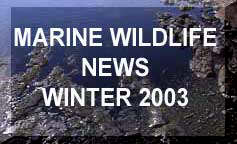 |
 |
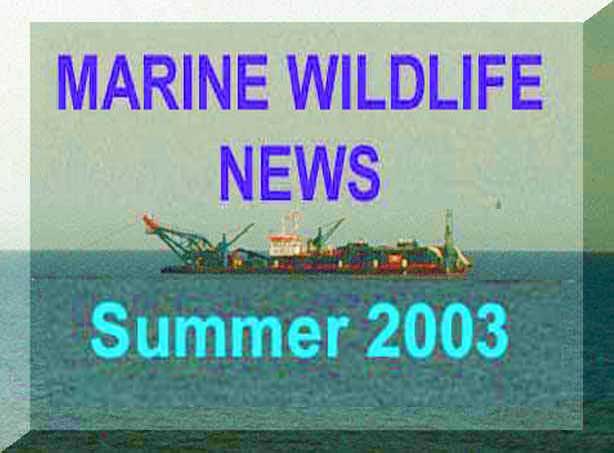 |
 |
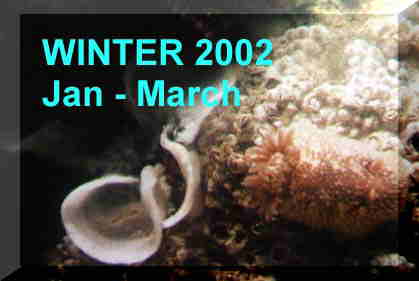 |
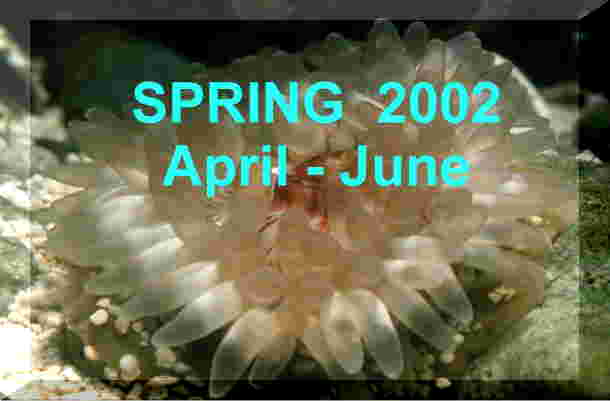 |
 |
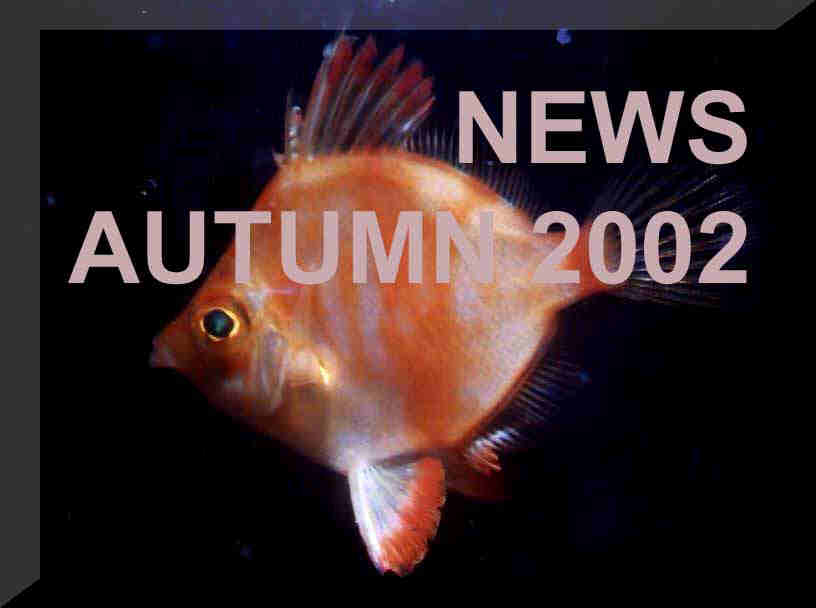 |
FOR EARLIER REPORTS CLICK ON THE BUTTON BELOW

The Marine Wildlife of the NE Atlantic Forum
PLEASE JOIN

MARINE WILDLIFE of the NE ATLANTIC EFORUM PAGE (LINK TO)
Nature Diaries [ Join Now | Ring Hub | Random | << Prev | Next >> ]
British
Marine Life Study Society
|
Use these links if your are familiar with the scientific classifications of marine life |
The BMLSS (England) site commenced on 1 January 1997
|
|
 |
 |
Andy Horton, Webmaster
|
|
|
|
|
|
Membership Form |
News 2003 News 2005 |










